5 Shoe Size Tips

When it comes to finding the perfect pair of shoes, one of the most critical factors is getting the right size. Ill-fitting shoes can lead to discomfort, pain, and even long-term foot problems. However, with the vast array of shoe sizes and styles available, navigating the world of shoe sizing can be daunting. Here are five expert tips to help you find your ideal shoe size and ensure a comfortable, perfect fit.
1. Measure Your Feet Accurately
The first step in finding your perfect shoe size is to measure your feet accurately. It’s surprising how many people haven’t measured their feet in years, if ever. Foot size can change over time due to various factors such as age, pregnancy, and weight gain or loss. To measure your feet, you can use a Brannock device, which is commonly found in shoe stores, or you can do it at home with a ruler and a piece of paper.
- Place the paper on a flat surface and stand on it with your weight evenly distributed on both feet.
- Draw a line at the back of your heel and another line at the tip of your longest toe.
- Measure the distance between these two lines to get your foot length.
- Compare this measurement to the size chart of the shoe brand you’re interested in. Remember, different brands can have slightly different sizing, so it’s always a good idea to check the specific brand’s size chart.
2. Consider the Width
While length is crucial, the width of your foot is also important for a comfortable fit. Many shoe brands offer different widths, from narrow to extra-wide. If you have particularly narrow or wide feet, looking for brands that cater to your foot width can make a significant difference in comfort. Some brands also offer a “medium” or “standard” width, which fits the average foot shape.
When trying on shoes, pay attention to how they feel across the ball of your foot and around your toes. If the shoe feels too tight or constricting, it might be too narrow. Conversely, if your foot slides around inside the shoe, it could be too wide.
3. Try Them On at the Right Time
The time of day you try on shoes can affect the fit. Feet tend to swell throughout the day, especially in warmer weather or after physical activity. For the most accurate fit, try on shoes in the late afternoon or early evening when your feet are at their largest. This ensures that the shoes will be comfortable throughout the day, even when your feet are slightly swollen.
4. Wear the Same Type of Socks
When trying on shoes, wear the same type of socks you plan to wear with the shoes. The thickness of your socks can affect the fit of the shoe. For example, if you plan to wear thick athletic socks with your new running shoes, try them on with similar socks to ensure a proper fit.
5. Walk Around the Store
Finally, don’t just stand still when trying on shoes. Walk around the store to get a feel for how they fit when you’re moving. Pay attention to any areas where the shoe might rub or feel too tight. Also, check if your heel slips out of the shoe when you walk, which could indicate that the shoe is too big.
How often should I measure my feet to ensure the best shoe fit?
+It's a good idea to measure your feet at least once a year, as foot size can change over time due to various factors. Additionally, if you've experienced significant weight changes, pregnancy, or any foot-related issues, it's a good idea to remeasure your feet to ensure you're wearing the right size.
Do all shoe brands use the same size chart?
+No, different shoe brands can have slightly different size charts. This is why it's important to check the size chart for each brand you're interested in, especially if you're shopping online. Some brands might also offer a "fit guide" or a way to measure your foot and compare it to their sizes.
Can shoe size affect foot health?
+Yes, wearing shoes that are too small or too large can lead to foot discomfort and potentially serious health issues, including bunions, calluses, and foot pain. Properly fitting shoes are essential for foot health, which is why taking the time to get the right size is crucial.
Following these tips can significantly improve your shoe-buying experience, ensuring that you find shoes that not only fit comfortably but also meet your specific needs, whether that’s for running, hiking, or just everyday wear. Remember, the key to happy feet is a combination of the right size, adequate support, and a comfortable fit.



